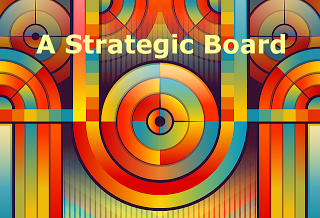The “Digitizing Boardroom” Book Introduction Chapter 2: A Strategic Board
 The board is accountable for strategy oversight and responsible for ensuring that the strategy being followed is appropriate for the organization and the environments within which the organization operates. The oversight of business strategy and change agenda are the two places where most boards can add value on, BoDs as top leaders need to have capabilities to think strategically for the business’s long-term prosperity.
The board is accountable for strategy oversight and responsible for ensuring that the strategy being followed is appropriate for the organization and the environments within which the organization operates. The oversight of business strategy and change agenda are the two places where most boards can add value on, BoDs as top leaders need to have capabilities to think strategically for the business’s long-term prosperity.
Strategic BoDs: There is a need for digital leaders such as BoDs who can think strategically and possess curiosity to ask WHY and knowing HOW of what strategic management is. Generally speaking, strategists have a clear vision, can think long term, master at both critical thinking and systems thinking to understand the business context. The power of context is in the way you can change the factors that create a context. Context is multidimensional in terms of understanding the scope - functional and physical, and a third aspect, to assist planning, risk assessment, etc. and to understand the environment in which the “something” will be developed and then operate. BoDs are the digital leaders who can set right priorities, follow the principles such as simplicity, also being learning agile to adapt to changes in the fast-paced digital environment.
BoDs think as “Outliers” to break silo thinking and criticize strategy: The traditional strategy is the view via narrow frames and considerably static timeline, but digital strategy view is broader to oversee business ecosystem, with the emergent property. It is definitely a different beast nowadays, because the speed of change is accelerating, Although the board often delegate the tasks such as strategy making to management. Nowadays, the boards perhaps need spend some time on participating strategy development as well because strategy-execution is a dynamic and iterative digital continuum. Strategy development is too often seen as a linear process, but it is, in fact, a cyclical process that needs constant attention and tuning. A cyclical approach also allows checks and balances and makes it easier to evaluate progress vs reality and business trends, which are moving too quickly to be taken for granted.
 BoDs present strategic wisdom to pinpoint pitfalls in Strategy Management: The strategy is the pillar of organizational existence, its vision, mission, design, structure, and functions. The strategy is no longer a static document file puts on the shelf, but a dynamic roadmap you should keep updating. You always should define a strategy, what the ups and down risks are and if realized, what to change. It is also not a stubbornly inflexible tool, but you must have reasons for change and drive consistent actions out of that change. Reducing barriers and optimizing connections and synergies are always beneficial. A strategic board is able to identify pitfalls on the way, monitor strategy implementation, and advise senior executive teams to overcome them and improve overall strategy management effectiveness.
BoDs present strategic wisdom to pinpoint pitfalls in Strategy Management: The strategy is the pillar of organizational existence, its vision, mission, design, structure, and functions. The strategy is no longer a static document file puts on the shelf, but a dynamic roadmap you should keep updating. You always should define a strategy, what the ups and down risks are and if realized, what to change. It is also not a stubbornly inflexible tool, but you must have reasons for change and drive consistent actions out of that change. Reducing barriers and optimizing connections and synergies are always beneficial. A strategic board is able to identify pitfalls on the way, monitor strategy implementation, and advise senior executive teams to overcome them and improve overall strategy management effectiveness. A strategic board reaches the high level of board maturity. In a world of well-defined problems, directors are required to exercise influence over volatility, manage uncertainty, simplify complexity, and resolve ambiguity in the 21st-century digital environment.
Follow us at: @Pearl_Zhu
Published on August 25, 2016 23:14
No comments have been added yet.



